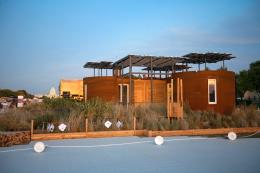Cornell University Sustainable Design

Erasing boundaries to collaborate on sustainability
One of the many features of Cornell Engineering that makes it stand out from other top-ranked colleges of engineering is the vast array of student project teams open to undergraduates. These teams are led by students and they give undergraduates hands-on experience designing, building, and testing (in competition) some very complex mechanical and technological systems.
There are currently 23 officially recognized student project teams housed in Cornell Engineering. These teams are remarkable for their autonomy, their professionalism, and their success. Many alumni of these teams attribute their early career success at least partially to the skills and lessons they learned outside of their official degree programs while members of one student project team or another.
Within the constellation of project teams at Cornell Engineering, one stands out for the diversity of both its membership and its projects. That team is called Cornell University Sustainable Design (CUSD). This year, CUSD has more than 100 members and several active projects. And while each project certainly requires some engineering expertise, CUSD is open to members from all of Cornell’s colleges. Both of the current advisors for the team, David Schneider and Sirietta Simoncini, are lecturers in Cornell’s Systems Engineering department.
A major focus of the CUSD team is making the design process for any new project one that emphasizes empathy and takes into account the needs of the end-users. This focus on making the design process responsive to user feedback is right up the alley of both CUSD advisors. David Schneider has worked for NASA and Disney and has designed competitions, educational programs, and video games in addition to technologies. Sirietta Simoncini is an architect by training who now teaches a product design class at Cornell Engineering. Her class is rooted in the ideas of Design Thinking.
Joshua Glasser ’18, an Urban and Regional Studies major in the College of Architecture, Art, and Planning at Cornell, says, “collaborating with peers from all over the seven different colleges in dozens of majors has been truly extraordinary. The strong sense of community has been a bedrock of my time at the University.” Glasser is currently the project leader on CUSD’s Beebe Lake Redevelopment Project. Students in his group have analyzed Cornell’s Beebe Lake and its surroundings and they have designed a building for the lakeshore that will flow naturally with the site and change the way the entire Cornell community interacts with natural areas of the campus. The group recently presented its plan to the Cornell Facilities Office and together they are now finalizing plans to actually construct the building.
The diversity of academic departments represented by project team members is to be expected, given the philosophical underpinnings of the design approach advocated by CUSD. When started in 2009 by Jeremy Blum ’13 M. Eng. ’12 B.S. this was the group’s mission statement: “Cornell University Sustainable Design utilizes an interdisciplinary, research-based approach in design and innovation to create resilient structures in the built environment and realize a future of ecological, social, and economic sustainability.”
CUSD lived up to this mission right off the bat. Their first completed project was the design and construction of a schoolhouse in Cosmo City, South Africa in 2011. The building was designed in a second-year Cornell Architecture studio and then constructed by 30 CUSD students. The schoolhouse uses passive heating and cooling systems and is designed to be low-maintenance.
Another successful CUSD project was called Sustainable Neighborhoods Nicaragua. Initially, the team of more than 50 Cornell students designed and built a healthy, low-cost, and sustainable model home in Nagarote, Nicaragua. CUSD used local materials, a community-based design, and low-tech sustainable systems to create a model that could be easily replicated. Their design is now being built throughout the country by a Nicaraguan nonprofit group called Sostenica.
Yodai Yasunaga ’17, a Design and Environmental Analysis major in Cornell’s College of Human Ecology, is currently serving as CUSD’s Director of Marketing and Communications. Yasunaga joined CUSD shortly after he started at Cornell. “I joined CUSD because I wanted to gain design experiences that reached beyond the classroom setting and made positive impacts on real people to solve real problems,” says Yasunaga. “Unlike typical class assignments, CUSD gives a chance for students to devote their time and efforts to make a real impact on the world.”
Other current projects through which students are hoping to make a real impact on the world are an exploration of the potential for on-site energy generation at the new Cornell Tech campus on Roosevelt Island in New York City, hands-on construction of a community building project in the town of Lansing, NY, creation of a ratings system to help consumers judge the sustainability of products, and consultation with Cornell on a University-wide action plan to achieve carbon neutrality by 2035.
CUSD shows no signs of slowing down or limiting its scope in the coming year. Marketing Director Yasunaga says, “As a group that has over 100 members and multiple complex projects, we seek talents from all different backgrounds. We value diversity in our membership to help us realize an interdisciplinary approach to our projects.” Team member Joshua Glasser concurs. “CUSD is on a constant drive to innovate. One of the biggest ways we are able to accomplish this is through a strong recruiting drive every semester. We are always looking for that next big idea from a student.”
To learn more about CUSD and its projects, click here.

